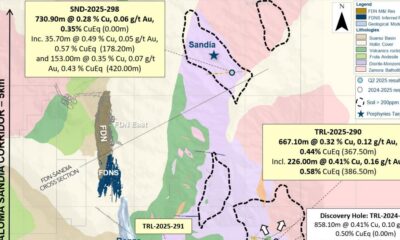Analys
Prices pull back as market awaits OPEC+ and demand signals


The Brent crude oil August contract traded briefly above the $40/bl line yesterday but has now pulled back again as the market is awaiting a decision by OPEC+ whether to roll current cuts of 9.7 m bl/d beyond June. We think that there is a better than even chance for this happening but a final decision is probably not available before mid-June as the group struggles with how to whip cheaters into line. Current demand signals from the US are also weak but will most definitely strengthen again at some point in time in the coming months. Crude oil prices are pulling back awaiting OPEC+ and demand signals. Use the opportunity to buy 2021.

The Brent crude August contract has had a great run from its lowest quote in late April of $22.45/bl to a close yesterday of $39.79/bl which is just below the 38.2% Fibonacci retracement level. The rally has been supported by both a revival in demand as well as a sharp reduction in supply. Both of these two forces are now being placed into question. US shale oil players are contemplating a reopening of shale oil wells which were closed when demand and prices crashed. OPEC+ is scheduled to bring back supply from July unless current discord can be overcome while recent demand indications in the US published this week were weakening for a third week in a row with total products delivered down 22.5% YoY. There is thus quite a bit of headwind right now to propel the Brent crude oil price above and beyond the $40/bl line for now.
All eyes are now naturally focused on OPEC+ and their deliberations over what to do in July. Reduce cuts from 9.7 m bl/d in May and June to 7.7 m bl/d in July and H2 overall as planned or roll current cuts of 9.7 m bl/d forward for an additional 1-3 months’ time. Saudi Arabia, Kuwait and UAE have also had an additional 1.2 m bl/d of above target cuts in June which might be cancelled in July.
Saudi Arabia and Russia indicatively seems to be willing to roll current cuts forward for another 1-3 months’ time but limited compliance to the agreement in April has become a significant stumbling block with Nigeria and Iraq the two biggest offenders. Unless these offenders can be reined in there is not going to be any forward rolling of current cuts of 9.7 m bl/d.
The proposed early OPEC meeting on the 4th of June has been ditched and now the originally planned meeting on June 9 to 10 is probably being shifted out in time to mid-June. This to review more data on compliance as Saudi Arabia is getting ready for hard-ball negotiations with OPEC-cheats. Without guarantees of full compliance Russia is unlikely to come along rolling cuts of 9.7 m bl/d forward into July. Not only are cheaters being pushed to fully comply with the deal going forward but they are also asked to make up for what they did not deliver in May and June by additional deeper cuts in July and August. That sounds like a very tall order. Our first instinctive reaction: this will never happen.
We don’t hold a strong view over whether current cuts of 9.7 m bl/d will be rolled forward for another 1-3 months or not. Maybe, maybe not. What we shouldn’t forget here is what happened on the 6th of March when Russia and Saudi Arabia fell apart as Saudi wanted to chase prices higher through further cuts while Russia was getting sick of cutting and just wanted to get back to business as usual. This underlying conflict is still there between the two parties in OPEC+ as it originates from the fact that Saudi Arabia has a presumed social break-even oil price of $80-85/bl while Russia’s is closer to $40/bl. As such they naturally get different goals and strategies with Russia favouring volume growth at an oil price in the range of $45-55/bl (if that is the oil price in a shale oil world) while Saudi Arabia unavoidably wants to chase prices to $60-70-80/bl through production cuts.
Saudi Arabia can and probably must at some point in time shift its social break-even oil price from current $80-85/bl and down towards $50/bl by increasing exports by 30-40% while cutting budget spending by 20-30%. This is also the messages that Muhammed bin Salman gave to Saudi Aramco and state departments following the break-down with Russia on the 6th of March this year. Though Covid-19, demand collapse and Donald Trump’s political pressure later forced Russia and Saudi to cooperate again.
Saudi Arabia and Russia’s interests are probably aligned as long as the oil price is below $40-45/bl, shale oil production is deteriorating while global oil demand is significantly below normal. But once we get to $50/bl, US shale oil wells are re-started, drilling rig count is ticking higher and global demand is moving closer to normal then we think that the dividing line between Russia and Saudi Arabia again is likely to re-emerge.
Russia is happy with an oil price around the $50/bl mark and wants to get its volumes back into the market again at such a price level rather than to see that US shale again starts to eat away at its market share.
It is very difficult for us to understand why OPEC+ agreed in late April to hold production cuts all to the end of April 2022. By doing so the group will give US shale oil producers all the time in the world to shape up, get bankruptcies out of the way and rebound production to the extent that oil prices allow it to do. This is the same recipe and the same mistake that OPEC+ did through 2017,18,19 when it held medium cuts for a long time. This gave US shale oil producers all the runway in the world to ramp up production. Getting its production cuts back into the market became forever impossible without crashing the oil price and Russia was caught in forever lasting cut agreement.
A much better solution would be to cut hard, deep and fast. As such we support a solution where current cuts of 9.7 m bl/d are rolled forward for another 3-6 months. But it should be coupled with the message that cuts will thereafter rapidly be placed back into the market through Q1/Q2 2021.
In this way US shale oil players will not have time to revive production other than to place closed wells back into operation. There won’t be a good reason to ramp up shale oil drilling and fracking either because OPEC+’ volumes will be placed back into the market again already in H1-2021.
As such we are inclined to believe that there is probably a better than even chance that OPEC+ will roll its current cuts of 9.7 m bl/d forward to July, August,.. rather than to reduce cuts down to the originally planned 7.7 m bl/d cuts.
For now oil prices are pulling back awaiting a decision by OPEC+. The Brent crude August contract could easily pull back towards the $35-36/bl level but would definitely rebound up and above the $40/bl line again if OPEC+ decides to roll the 9.7 m bl/d cuts forward beyond June. Stronger demand revival signals would also be welcome. They will come for sure. Peak oil demand? Not at all yet. We will move back up to 100 m bl/d again and above. Just a matter of time.
The Brent crude oil August contract closed just a fraction below the 38.2% Fibonacci retracement level yesterday. Now pulling back on weakness in US demand signals as well as awaiting a decision by OPEC+

Total US products delivered has dissapointed now three weeks in a row. It all looked good in terms of demand revival until mid-May but since then it has been a sad story
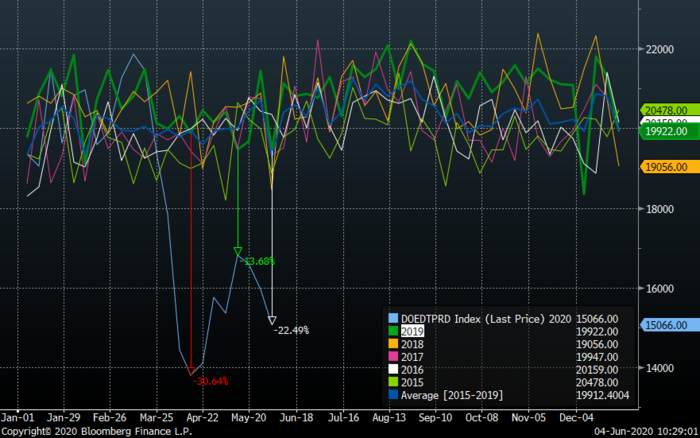
It is deliveries of US mid-dist products which is the weakness here. That is typically diesel and jet fuel.
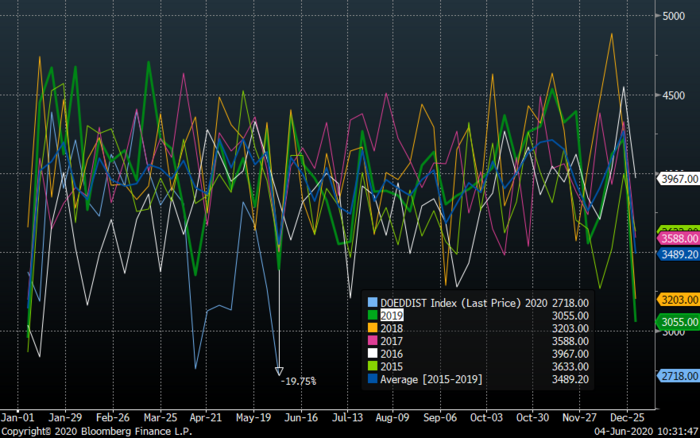
Deliveries of jet fuel in the US is still down 79% YoY. No solid signal of rebound yet there.
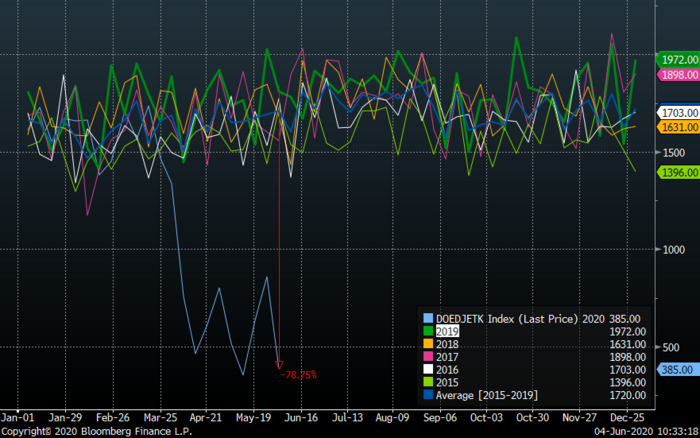
US crude oil continues to fall sharply in a combination of structural decline and deliberate shutting of wells. The underlying losses in US shale oil crude and NGL production in the US is in the range of 600 – 800 k bl/d per month. Currently there are only 222 active oil rigs in the US. These have an implied productive effect of about 165 k bl/d per month of new supply if all the wells they produce are placed into production (probably not done now). There is thus a significant ongoing structural decline in the US of up to 400 – 600 k bl/d per month today.
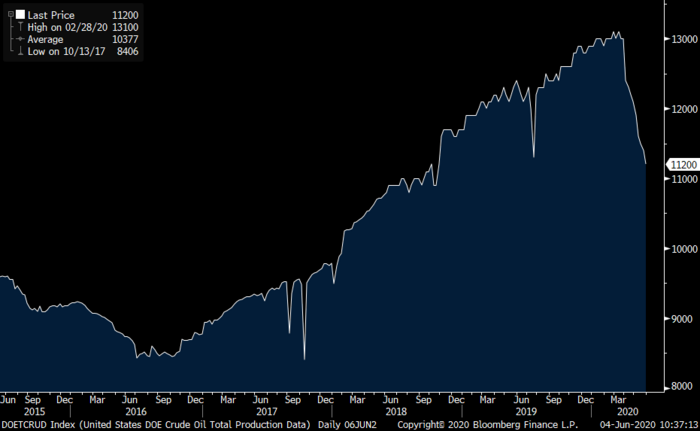
The Brent crude oil time spread of the 1 month minus the 6 month contract. The contango moved deeper than in 2009 but has come back faster. The front-month Brent contract has actually been in backwardation vs the second contract briefly in intraday trading lately. If cuts of 9.7 m bl/d are rolled forward beyond June then market is likely to move into deficit, inventories drawing down and poff we are back in backwardation.
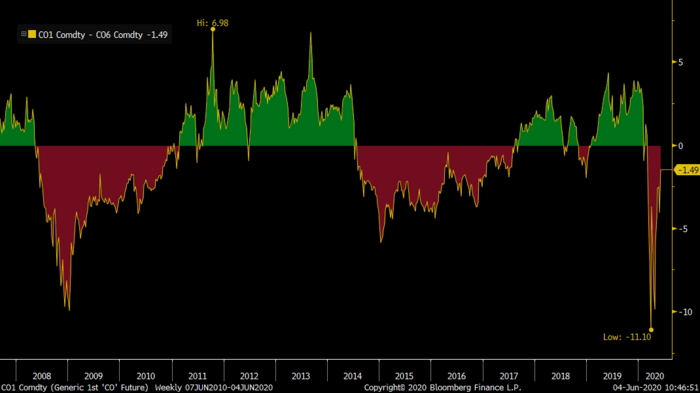
The current set back in crude oil prices can provide yet another chance to purchase forward Brent crude for 2021 average delivery at very low, favorable price levels. We strongly advised our clients to purchase crude and oil products when the forward Brent 2021 contract traded in the range of $35-40/bl. We still view low-40ies as a very favorable level.

Analys
OPEC+ in a process of retaking market share

Oil prices are likely to fall for a fourth straight year as OPEC+ unwinds cuts and retakes market share. We expect Brent crude to average USD 55/b in Q4/25 before OPEC+ steps in to stabilise the market into 2026. Surplus, stock building, oil prices are under pressure with OPEC+ calling the shots as to how rough it wants to play it. We see natural gas prices following parity with oil (except for seasonality) until LNG surplus arrives in late 2026/early 2027.

Oil market: Q4/25 and 2026 will be all about how OPEC+ chooses to play it
OPEC+ is in a process of unwinding voluntary cuts by a sub-group of the members and taking back market share. But the process looks set to be different from 2014-16, as the group doesn’t look likely to blindly lift production to take back market share. The group has stated very explicitly that it can just as well cut production as increase it ahead. While the oil price is unlikely to drop as violently and lasting as in 2014-16, it will likely fall further before the group steps in with fresh cuts to stabilise the price. We expect Brent to fall to USD 55/b in Q4/25 before the group steps in with fresh cuts at the end of the year.

Natural gas market: Winter risk ahead, yet LNG balance to loosen from 2026
The global gas market entered 2025 in a fragile state of balance. European reliance on LNG remains high, with Russian pipeline flows limited to Turkey and Russian LNG constrained by sanctions. Planned NCS maintenance in late summer could trim exports by up to 1.3 TWh/day, pressuring EU storage ahead of winter. Meanwhile, NE Asia accounts for more than 50% of global LNG demand, with China alone nearing a 20% share (~80 mt in 2024). US shale gas production has likely peaked after reaching 104.8 bcf/d, even as LNG export capacity expands rapidly, tightening the US balance. Global supply additions are limited until late 2026, when major US, Qatari and Canadian projects are due to start up. Until then, we expect TTF to average EUR 38/MWh through 2025, before easing as the new supply wave likely arrives in late 2026 and then in 2027.
Analys
Manufacturing PMIs ticking higher lends support to both copper and oil

Price action contained withing USD 2/b last week. Likely muted today as well with US closed. The Brent November contract is the new front-month contract as of today. It traded in a range of USD 66.37-68.49/b and closed the week up a mere 0.4% at USD 67.48/b. US oil inventory data didn’t make much of an impact on the Brent price last week as it is totally normal for US crude stocks to decline 2.4 mb/d this time of year as data showed. This morning Brent is up a meager 0.5% to USD 67.8/b. It is US Labor day today with US markets closed. Today’s price action is likely going to be muted due to that.

Improving manufacturing readings. China’s manufacturing PMI for August came in at 49.4 versus 49.3 for July. A marginal improvement. The total PMI index ticked up to 50.5 from 50.2 with non-manufacturing also helping it higher. The HCOB Eurozone manufacturing PMI was a disastrous 45.1 last December, but has since then been on a one-way street upwards to its current 50.5 for August. The S&P US manufacturing index jumped to 53.3 in August which was the highest since 2022 (US ISM manufacturing tomorrow). India manufacturing PMI rose further and to 59.3 for August which is the highest since at least 2022.
Are we in for global manufacturing expansion? Would help to explain copper at 10k and resilient oil. JPMorgan global manufacturing index for August is due tomorrow. It was 49.7 in July and has been below the 50-line since February. Looking at the above it looks like a good chance for moving into positive territory for global manufacturing. A copper price of USD 9935/ton, sniffing at the 10k line could be a reflection of that. An oil price holding up fairly well at close to USD 68/b despite the fact that oil balances for Q4-25 and 2026 looks bloated could be another reflection that global manufacturing may be accelerating.
US manufacturing PMI by S&P rose to 53.3 in August. It was published on 21 August, so not at all newly released. But the US ISM manufacturing PMI is due tomorrow and has the potential to follow suite with a strong manufacturing reading.
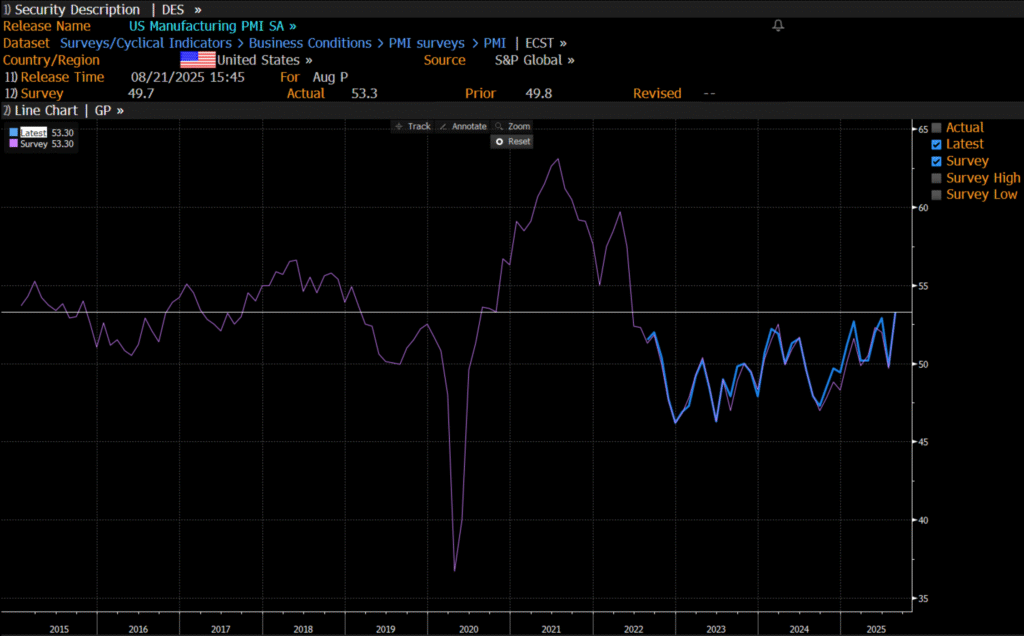
Analys
Crude stocks fall again – diesel tightness persists

U.S. commercial crude inventories posted another draw last week, falling by 2.4 million barrels to 418.3 million barrels, according to the latest DOE report. Inventories are now 6% below the five-year seasonal average, underlining a persistently tight supply picture as we move into the post-peak demand season.

While the draw was smaller than last week’s 6 million barrel decline, the trend remains consistent with seasonal patterns. Current inventories are still well below the 2015–2022 average of around 449 million barrels.
Gasoline inventories dropped by 1.2 million barrels and are now close to the five-year average. The breakdown showed a modest increase in finished gasoline offset by a decline in blending components – hinting at steady end-user demand.
Diesel inventories saw yet another sharp move, falling by 1.8 million barrels. Stocks are now 15% below the five-year average, pointing to sustained tightness in middle distillates. In fact, diesel remains the most undersupplied segment, with current inventory levels at the very low end of the historical range (see page 3 attached).
Total commercial petroleum inventories – including crude and products but excluding the SPR – fell by 4.4 million barrels on the week, bringing total inventories to approximately 1,259 million barrels. Despite rising refinery utilization at 94.6%, the broader inventory complex remains structurally tight.
On the demand side, the DOE’s ‘products supplied’ metric – a proxy for implied consumption – stayed strong. Total product demand averaged 21.2 million barrels per day over the last four weeks, up 2.5% YoY. Diesel and jet fuel were the standouts, up 7.7% and 1.7%, respectively, while gasoline demand softened slightly, down 1.1% YoY. The figures reflect a still-solid late-summer demand environment, particularly in industrial and freight-related sectors.


-
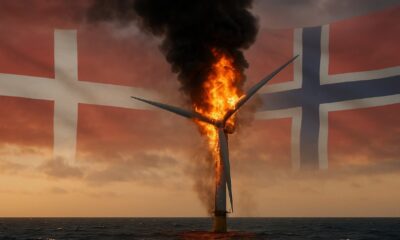
 Nyheter4 veckor sedan
Nyheter4 veckor sedanOmgående mångmiljardfiasko för Equinors satsning på Ørsted och vindkraft
-

 Nyheter2 veckor sedan
Nyheter2 veckor sedanMeta bygger ett AI-datacenter på 5 GW och 2,25 GW gaskraftverk
-

 Nyheter4 veckor sedan
Nyheter4 veckor sedanGuld stiger till över 3500 USD på osäkerhet i världen
-

 Analys4 veckor sedan
Analys4 veckor sedanWhat OPEC+ is doing, what it is saying and what we are hearing
-

 Nyheter2 veckor sedan
Nyheter2 veckor sedanAker BP gör ett av Norges största oljefynd på ett decennium, stärker resurserna i Yggdrasilområdet
-
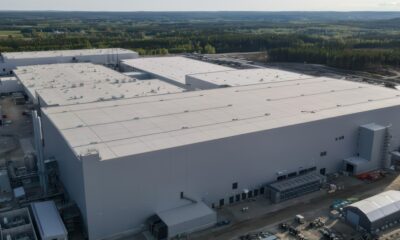
 Nyheter4 veckor sedan
Nyheter4 veckor sedanLyten, tillverkare av litium-svavelbatterier, tar över Northvolts tillgångar i Sverige och Tyskland
-

 Analys2 veckor sedan
Analys2 veckor sedanBrent sideways on sanctions and peace talks
-
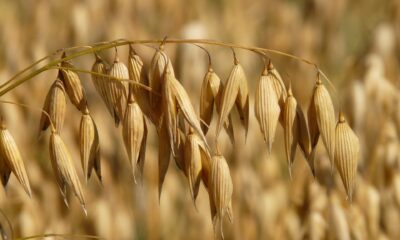
 Nyheter3 veckor sedan
Nyheter3 veckor sedanEtt samtal om koppar, kaffe och spannmål




